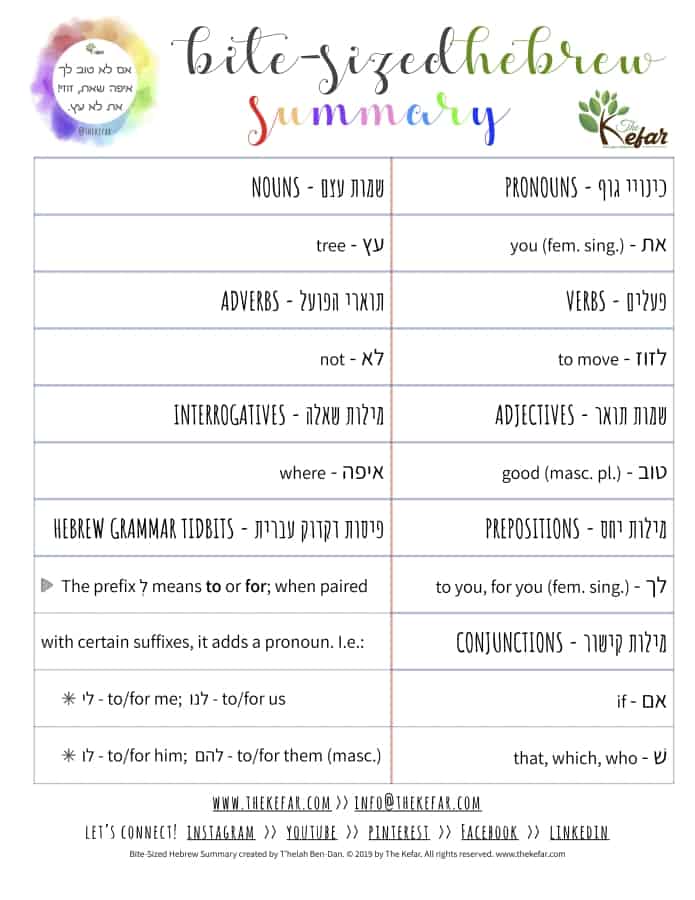I can’t believe how quickly 2018 has flown by! Only 6 months ago I was in nature’s backyard, living and teaching in southern Israel, and now I’m about half way through the school year here in the states (and very ready to be done, done). It’s business as usual over here – Hebrew lessons being taught, curriculum design projects being executed, and A Tale of Two Midwives being finalized to print next month!
This Lesson #6 is part of my monthly Hebrew Through Reading (HTR) series. (In case you missed the first several, you can read lessons one, two, three, four, and five here.) As usual, we’ll translate a quote word by word, phrase by phrase, using my four steps to improving Hebrew reading.

Listen to me read the quote here 3x
.אִם לֹא טוֹב לָךְ אֵיפֹה שֶׁאַתְּ, זוּזִי! אַתְּ לֹא עֵץ
אִם [im] is a conjunction that means if, which we covered in Lesson 2.
לֹא [lo] is another word we covered in Lesson 2 – it means no or not.
טוֹב [tov] is a singular masculine adjective that means good. We talked about the plural form of this adjective, and some adjective rules, in Lesson 4.
לָךְ [lach] is a preposition that means to you or for you. Actually, the preposition part of this word is the prefix לְ [lǝ], which means to or for. When paired with certain endings, it links the to/for with a pronoun. For instance, לִי [li] means to/for me; לָנוּ [lanu] means to/for us.
So far, we have: If not good to/for you…. As you can tell, this is super awkward. Let’s translate a little more and see what word(s) we should add/rework to make the phrase make sense in English.
אֵיפֹה [eifoh] is an interrogative (question word) that means where.
שֶׁאַתְּ [she’at] is a combination of the prefix שֶׁ [she], and the pronoun אַתְּ [at]. We covered the prefix שֶׁ – meaning that, which, or who – in Lessons 3, 4, and 5; it’s a really common occurrence!
When אֵיפֹה is used as a statement as opposed to a question (i.e. I’m where we met yesterday vs. where are you?), you must also use the prefix שֶׁ – it doesn’t translate well in English (i.e. I’m where that we met yesterday), but the “that” is needed in Hebrew to link the “where” with the information that follows it.
This gives us: If not good to/for you where you…. We can add it’s here, in between if and not, and add are after the you; both of these additions make the translation make sense in English, without changing the meaning of the sentence.
With these minor (but necessary) changes, we now have: If it’s not good to/for you where you are….
זוּזִי [zuzi] is the imperative (command) form of the verb לָזוּז [lazuz], which means to move. It’s the feminine singular command – move! – which makes sense since the statement also addresses a feminine singular you.
We’ve already covered את and לא in this lesson, so now we have: If it’s not good to/for you where you are, move! You are not….
עֵץ [eits] is a masculine noun that means tree; it can also mean wood.
Putting this all together, we have “If it’s not good to/for you where you are, move! You are not a tree.” Now that we’ve translated the entire quote, we can choose for you instead of to you.
Our final translation is…
IF IT’S NOT GOOD FOR YOU WHERE YOU ARE, MOVE!
YOU’RE NOT A TREE.
Be sure to pin the Bite-Sized Hebrew Lesson summary below so you can always refer back to it.
Please leave your feedback in the comments below!!
Until next time!
-T’helah 💙

👇🏾 PIN THIS PIC 👇🏾


